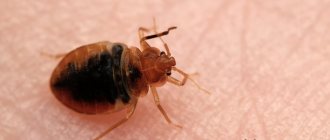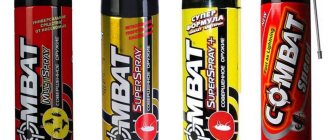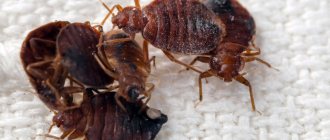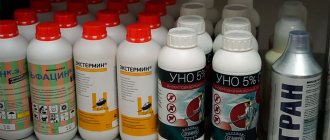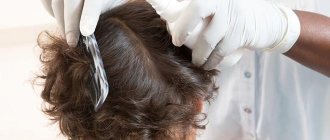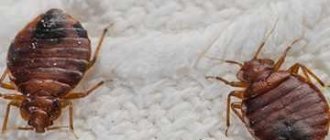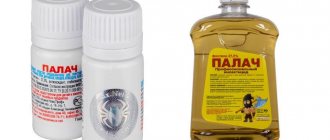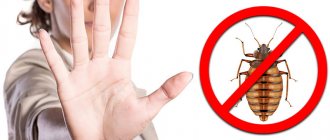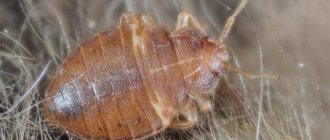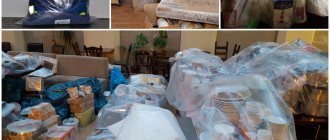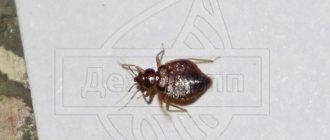Most people who have bed bugs in their homes are afraid that bed bug killers can be dangerous to both people and pets. And most often people ask us, both by phone and by mail, how dangerous are the products that we use to bait bedbugs and which can be purchased to independently remove these parasites.
Moreover, we know from communication with our clients that the two main factors due to which they do not order extermination immediately after discovering bedbugs are the cost of disinfestation, which seems to them higher than self-baiting, and the risk of poisoning with means used to kill parasites. Even in cases where the cost of treatment is not critical for a person, he very often delays it and looks for other ways to get rid of insects precisely because he is afraid of the supposed toxic effect of the drugs.
Therefore, let’s dot all the i’s and figure out how dangerous the means that can really kill bedbugs really are, whether they are dangerous at all, and how to choose the safest ones among them.
Let's start with the essence of the issue. There are three important facts here, such unique axioms. First:
All means for killing bedbugs vary in their danger to humans
If we take into account all the means that can kill bedbugs and are used for this purpose, then among them there are both extremely dangerous drugs and almost absolutely safe ones.
For example, there are cases when craftsmen managed to place tablets containing aluminum phosphide in the house. This is a critically dangerous product that is sometimes used to kill borer beetles, but this is done with the strictest safety measures - only in detached houses, which are covered with huge fabric covers from the roof to the ground and in which until the active substance is completely removed for a week or two Neither people nor pets are allowed to enter.
Yes, such tablets will certainly destroy bedbugs. But whether the people who live in this house, use such pills themselves, and return to it after destroying the parasites, will remain unharmed - that’s the question. Moreover, someone might come up with the idea of putting such powerful pills in an apartment, which is completely unacceptable.
On the other hand, there are remedies that are quite effective against bedbugs and completely safe for humans. The same Hector and Ecokiller reliably kill bedbugs and, when used correctly, destroy them in one treatment. And they act on humans in the same way as chalk acts. That is, they have practically no effect.
And between these extremes there are several hundred drugs that differ in their danger to humans.
This means that it is at least unreasonable to be afraid of all the means to kill bedbugs. This is the same as considering all mushrooms without exception to be poisonous. We know that among them there are both very poisonous and completely non-poisonous and completely edible. And there are intermediate forms - weakly poisonous, conditionally poisonous, non-poisonous, but not edible either. The same goes for bedbug exterminators.
Therefore, we cannot say that all bedbug repellents are dangerous, or, conversely, safe. The danger of each specific drug must be studied and taken into account when used at home.
Preparing the apartment
Regardless of the chosen disinfection method, if a full-scale treatment is planned, then the apartment also needs preliminary preparation for this procedure.
Preparatory measures are as follows:
- Removing carpets if they are hanging on the walls.
- All folding furniture, such as sofas or armchairs, must be disassembled first.
- All clothes and other things from closets must be removed and packed in secure and airtight bags; after processing, all this will need to be washed in hot water.
- All apartment residents, as well as pets, must be absent during the treatment of the premises and not appear there until the insecticides have completely evaporated.
If the apartment is processed by a professional service and the products they use require any additional precautions, then the specialists will definitely warn you about this.
People tend to exaggerate the dangers of most drugs
This means that in fact most of the remedies are less dangerous than they seem at first glance.
The fact is that most people are lazy. And instead of really studying the effect of a specific drug, and even more so its active substance on the human body, they prefer to be guided by common stereotypes that:
- Chemistry is dangerous;
- If a product poisons insects, it will poison people;
- Industrial “chemicals” are more dangerous than folk remedies.
Moreover, when making decisions, a person usually relies on such stereotypes unconsciously. Like, chemistry means it’s bad. And weed means good.
The problem here is that it is easier to put such a “Dangerous” stamp on any product than to later remove bedbugs using such stamps. Confirmation of this is the grandmothers who categorically refuse disinfestation and industrial insecticides, have been “scaring” bedbugs for years with tansy and wormwood, and have been breeding thousands of these parasites in their homes. If you don’t want to breed bedbugs like these grandmothers, change your stereotypes.
Why do bedbugs sometimes survive?
There are cases when individual individuals can survive, and sometimes people themselves help them in this out of ignorance or due to insufficient experience in carrying out treatments:
- during the destruction of bedbugs, the products did not penetrate into hard-to-reach places where there were insect nests;
- a coordinated destruction of parasites was not carried out jointly with neighbors, and the insects returned;
- due to the incorrect selection of insecticides, the bedbug eggs survived and new offspring hatched;
- After treatment, general wet cleaning was immediately carried out (all long-acting products were washed away).
In order not to give bloodsuckers a chance to live, you should follow the simplest rules shown after treating your home.
Cases of severe poisoning from bedbug repellents are extremely rare.
Most medications for home use are designed to be used by people who do not have special training, special personal protective equipment, or experience working with hazardous substances. Simply put, they implement the so-called “fool protection”, and it is also stipulated that in case of some violations of the instructions for use, nothing terrible should happen.
Indeed, if you try to find reports of poisonings, and even more so of deaths after using the most famous bedbug drugs, you will not find them. For example, look for reports of people being seriously poisoned by Raid, or Raptor, or Executioner. The maximum that can be found are messages in reviews either that someone was dizzy, someone had an allergy, someone felt sick after using such products. But in such cases, you always need to check whether the person followed the instructions for using the product - whether he was wearing a respirator, whether he treated the room in long sleeves, or whether he washed his face after accidentally getting the product on his face. If such requirements were not fully observed, then talking about the dangers of the product is the same as complaining about the dangers of a car in which “I’m my mother’s racer” accelerated to great speed in the city center, forgot to buckle up and lost control...
Therefore, by the way, professional pest control using any means to kill bedbugs is as safe as possible for people. Simply because the exterminator, who is well trained and equipped, monitors compliance with safety measures. And he works with the product correctly and according to the instructions. And there are practically no known cases of such poisoning after professional disinfection.
This means that in reality it is not so much the anti-bedbug remedies that are dangerous, but the mistakes of people using these medications. And all means are designed to ensure that, if the rules for their use are followed, they will not cause any harm to a person.
These are the most general principles that need to be understood. Now let's look at more specific nuances.
Self-treatment of residential premises
So, you wanted to manage the process of treating rooms from bedbugs. Well, perhaps we’ll classify this as smart decisions.
Follow this path beaten a thousand times by voyages:
- Remove furniture from the room, pour boiling water over wooden structures... (see above).
- Dilute the purchased emulsion (“Executioner”, “Foxide”, “Karbofos”, etc.) in water placed in a spray bottle. Warm it up a little in advance. Don't be afraid of sediment - it's natural. Wear a respirator, gloves - and bayonets!
- Spray on trims, cornices, hinges, wardrobes, beds (then wash what you need). Don't mess around with sockets, they don't tolerate this approach! It’s better to pour a dry mixture (“Neopin”, “Riapan”) onto a rag or sponge, and then spread it around the outlets. Don't forget to sprinkle "misbehaving" powders under the bedposts. It won't kill you - it will scare you away!
- Let us mention here the old-fashioned method, which allows you to maintain some kind of defense if you are already completely stuck and simply unbearable. Take four plastic bottles, cut off the necks and get rid of the cone-shaped part. Move your bed away from the sides and place your feet in these bottles filled with water. Keep in mind: this is all done on a voluntary basis. This won’t be needed at all after a local spill.
- Is the work completed? Then close all windows and doors and move to another place for a couple of days. Before removing, pour ammonia into several bowls and place them in the rooms. At worst, vinegar will do. When you return, ventilate your home, but do not do general cleaning! Yes, this has already been mentioned earlier, but this aspect is still incredibly important! Wipe the floors in the center of the rooms, clean the areas near the beds, but do not completely remove chemical residues.
- The turn of the final stage has come. Permanently after the process of irrigation of rooms with insecticides, barely visible linen settles on mirrors and glass coverings. Tile and parquet floors may be susceptible to this. The sediment is wiped off with cleaning products (household chemicals). Let’s say Mr.Proper does an excellent job of his duties (and he’s not the only one; there are tons of such products).
How can insecticides affect the human body?
Those mechanisms in the bodies of bed bugs that are affected by insecticides are generally identical for both insects and humans.
For example, most drugs for bedbugs disrupt the mechanism of impulse transmission in nervous tissue. It is due to this action that they lead to paralysis in bedbugs and their death.
Nervous tissue in humans is generally structured in the same way as in insects. Therefore, one might assume that bedbug remedies should also lead to paralysis in humans.
However, this does not happen even in cases where, for some reason, a significant amount of insectoacaricide enters the human body. This is due to the fact that in bedbugs and other insects - cockroaches, for example, or fleas, the final effect on the nervous tissue is not the substance that is in the spray bottle, but its derivatives, into which the original insecticide is converted under the influence of various enzymes in the insect body. That is, the insecticide enters the body of the bug, where it is transformed into another substance in the hemolymph, sometimes in the nervous tissue it turns into another, and the final product of such transformations acts on nerve receptors, or synapses, or on neuroglia.
But in the human body such transformations do not occur due to a different set of enzymes and a generally different environment into which the insecticide enters. It’s commonplace that in a bug the toxic substance enters the hemolymph, and in a person it either enters the digestive juice in the stomach or the blood from the lungs. And the compositions of hemolymph, blood and gastric juice are completely different. And the process that takes place in the hemolymph of a bug will not start in human blood.
The simplest example: let’s take malathion (its other name, better known, is karbofos). Once in the body of a bug, it turns into malaoxon on its way to the nervous tissue, which is much more active and toxic to the insect. It is malaoxon that poisons the insect. But in the body of warm-blooded animals, including humans, dogs or cats, malathion is either not converted into malaoxone at all, or is converted slowly, in very small quantities, and the final malaoxone is hydrolyzed much faster. As a result, malathion specifically does not have the same neuroparalytic effect on people as on bedbugs.
The situation is approximately similar with other insecticides. Some do not transform into highly toxic substances, while others do, but very slowly. Only a few of them affect people in the same way as they do insects.
But at the same time, almost all insecticides in large quantities are toxic to humans. It doesn’t matter whether they act on the human body in the same way as on the body of a bug, or lead to poisoning through a different mechanism, but they have a toxic effect. Therefore, if you drink a liter of Karbofos, you can be seriously poisoned, and if you inhale an aerosol with lambda-cyhalothrin, you can suffocate.
Most insecticides can cause an allergic reaction upon contact with the skin, or irritation and itching upon contact with mucous membranes (for example, in the eyes). However, the likelihood of such an allergy in an individual person is the same as when working, for example, with household detergents or food products. That is, insecticides are no more allergenic than toilet gel or natural spices.
All this means that in fact the danger lies not in the product, but in its quantity. We remember that in certain quantities a medicine can turn into poison. And in some quantities the insecticide is harmless, but in large quantities it is already dangerous.
All this is relevant for insecticides that are used in the form of a liquid solution. Moreover, their danger manifests itself only in such a liquid state. When these solutions dry on surfaces, they do not pose a danger to humans even if they accidentally come into contact with such a treated surface.
That is why properly produced insecticides for home use contain such concentrations of active substances that will lead to the destruction of bedbugs, but will not allow them to poison a person even if there are occasional minor errors in their use on the part of an inexperienced handler. At the same time, as we remember, the means vary in their danger to humans. And among them there are those that need to be used very carefully, and there are those that even with a strong desire cannot be poisoned.
Therefore, for clarity, you need to understand the danger or safety of the most common household means for killing bedbugs.
How to prepare an apartment or house for processing?
Regardless of which method of expelling bedbugs you are inclined to use, the room will still have to be adapted. Keep in mind that without insecticides there are almost no victories!
Bedbugs love to climb under baseboards, live in the cracks of window sills, and while away their time in the refrigerator. To squeeze through to these places, you need to work hard. How to prepare an apartment for treatment against bedbugs? Very simple…
“Feng Shui out of necessity” is done in stages:
- Deprive the room of furniture and other interior items (if possible). Insects can be behind paintings, wall posters, or in curtains. It is not necessary to remove this, since with due diligence after baiting, the trace of them will disappear. Plants in pots and animals wearing collars must be transported.
- Do a wet cleaning in the apartment. Sometimes people manage to discover nests with parasites. After using chemicals, wet cleaning should be carried out after a week. This makes it possible for poisons to finally drive out unregistered residents.
- Separately from the rest, pour boiling water over oak, spruce, pine, and ebony products without hesitation. Literally bring the furniture into the bathroom and run hot water over it. The scalded scoundrels will quickly crawl out of their hidden places.
- It is recommended to treat the paths too. Due to thick pile or other material, arthropods can become embedded in the carpet. Noticing a tar spot can sometimes be problematic, so act for your own good! By the way, if it’s winter outside with snowdrifts, these piles of swan’s down, then take the carpets out into the fresh air. They also need periodic ventilation! Shake out the tapestry brother, then throw snow over the entire cavity and rub away the sediment. After that, bring it home.
- Take your children's soft toys to the dry cleaner. Do the same with bedding.
- Place the food in the refrigerator. For greater safety, use cellophane in the wrapping format. Electrical equipment is allowed to remain during the “therapy session” of the room. The ideal raincoat for them would be polyethylene. Cover the kitchen table, at least for the sake of aesthetics, with a chintz sheet or something else.
- If you decide to leave the wardrobe, then at least throw some clothes in it. However, it is not recommended to do this, because bedbugs love clothes no less than any fashionista. Accordingly, they set up camp in the closet.
- It’s easy to deal with sconces and chandeliers: just remove the lampshades, and fluid artillery will handle the rest.
After the room(s) are abandoned, you need to rush into the attack!
Executioner
The active ingredient of the Executioner is fenthion, a compound from the organophosphorus group, the same one to which the above-mentioned karbofos belongs. The drug acts on the human body in a similar way to malathion-based products: if significant quantities enter the respiratory or digestive tract, typical poisoning can develop, which quickly resolves when adequate measures are taken.
In the photo there are 5 Executioner bottles, which are enough to kill bedbugs in a one-room apartment:
There are no known cases of severe poisoning by Executioner when used at home. At a minimum, people don’t drink it in glasses, and they can’t breathe it for a long time because of its unpleasant smell. The instructions for use of the Executioner indicate that you can spray the room with it only in a respirator, long sleeves and glasses. If these requirements are met, the likelihood of poisoning will be minimal.
Both in composition and in terms of safety profile, the Executioner is similar to Forsyth. Both products are considered one of the most powerful preparations for self-treatment of apartments.
Disinfection procedure
Even if it was decided not to use the services of insect removal specialists, if you treat the premises yourself, the disinfection procedure will look the same.
Destruction of bedbugs involves the following set of measures:
- Poisoning the nest, as well as all places where bedbugs may be located, with insecticides. The most effective remedies against them are Tetrix, Biorin, Ectermin or Sinuzan.
- All people not taking part in the processing of the apartment must leave the premises.
- If necessary, treat carpets and interior cabinet surfaces with insecticides.
- Additionally, it is necessary to wash all clothing and bedding to eliminate any remaining parasites. Washing must be done at high temperature, after which all linen must be ironed, paying special attention to seams and other hard-to-reach places.
Get Total
Get Total contains chlorpyrifos as an active component - a rather toxic substance that cannot be used in a simple diluted form in domestic conditions. Therefore, Get Total includes this component in microencapsulated form - this way it is much safer for humans, but is also effective against bedbugs. As a result, Get Total is considered one of the safest, but at the same time effective drugs for controlling insects in the house.
Interestingly, due to microencapsulation, Get Total has virtually no odor characteristic of organophosphorus compounds.
Criteria for choosing a disinfection service
In order not to regret your choice in the future, you need to take this process as seriously as possible.
First of all, you need to pay attention to the following factors that can influence the choice of professional service:
- Reputation of the selected organization. Today, there are a large number of companies providing such services, so you can always choose in favor of specialists who have already proven themselves on the most positive side.
- The methods the service uses to kill insects. In particular, you need to find out how safe the poisonous drugs are if chemical treatment is used, as well as the guarantee that specialists are willing to provide, usually from 1 to 3 years.
- Value for money. Since the competition in this industry today is quite strong, it makes no sense to overpay for the service, however, unreasonably low prices should also put you on guard. Even the presence of good reviews can only be a trick of scammers.
- Quality of service and attitude towards potential clients. These are criteria that many people do not attach importance to, but they are extremely important. If employees of an organization are rude when communicating with potential clients on any issues, and if the office environment is careless or looks like a temporary workplace, then this should warn against possible cooperation.
Hector
Of all the effective remedies for bedbugs, Hector is considered the safest for people. Chemically it is inert, does not interact with organs and tissues, does not cause irritation on mucous membranes and does not lead to poisoning. It consists almost entirely of silicon dioxide, a substance found in toothpastes, tablets, medical and cosmetic creams as a forming agent. That is, in fact, the only component of Hector is that people eat, drink, and smear it on their body and teeth without harming themselves.
Hector may pose some danger due to its physical form - it is a fine dust-like powder, which, if inhaled, can cause coughing, and in large quantities - pulmonary silicosis. However, such consequences appear when there are gross violations of the rules for its use - spraying into the air rather than on the surface, using excessive quantities of the drug, when there is literally a three-centimeter layer of powder in the house. If you don’t go too far, then Hector does not pose any danger to humans, even if you use it without then leaving the room.
The photo below shows bedbugs that died from dehydration after contact with Hector:
Much the same can be said about any remedy for bedbugs. If its active substance belongs to the class of pyrethroids or organophosphorus compounds, then theoretically in large quantities it can be dangerous to humans, but in fact, with proper, careful use, the risk of developing any undesirable consequences from the use of such drugs will be minimal.
Familiar and proven chemicals
There are no absolutely safe chemical preparations for bed bugs, but there are some whose risk of poisoning is minimized if the dosage is observed:
- Tetrix against bedbugs. A very effective and fast-acting product without a strong odor. Suitable for treating any residential premises, does not leave streaks or stains;
- Combat Superspray. Low toxicity for humans and warm-blooded animals, low odor;
- Ram. Economical in consumption, low-hazard drug for humans;
- Executioner. Used in places where insects accumulate, low toxicity for people and animals;
- Dobrohim Phos. A universal drug against all household pests.
- Dobrokhim-micro. It is based on the active compound chlorpyrifos. Can be used even in children's institutions;
- Spray Clean House with chamomile extract. Does not contain chemical gases. The product must be used to treat detected and suspected places where insects accumulate - baseboards, sockets, joints in furniture structures.
All of the drugs listed have the lowest hazard class, but some danger still remains. Before use, please read the recommended method of use and full instructions on the package.
Which drugs are really dangerous?
There are also means that can destroy bedbugs, but which are extremely dangerous for humans and which cannot be used in apartments and residential buildings. These include:
- Tablets with aluminum phosphide - upon contact with moisture from the air, phosphine is released from them, which completely mows down all living things, including plants. You should not stay in the room in which such tablets are laid out until they are completely decomposed and then for several days after the start of ventilation. It is also unacceptable for gas to escape from these tablets outside the premises, so they cannot be used in ordinary apartments and houses;
- Sulfur bombs, the smoke from which is approximately equally toxic to both humans and insects. Moreover, even if the handler himself lights them in a respirator, the smoke from them can penetrate through the ventilation into neighboring apartments and poison their residents;
- Smoke bombs based on pyrethroids (permethrin, lambda-cyhalothrin and others) are dangerous for the same reason as sulfur bombs: the smoke from them can enter rooms where there are people without personal protective equipment.
All such products are officially prohibited for use in residential premises and their use in apartments and houses is a violation of the instructions. If someone gets poisoned after such a violation, the offender will bear responsibility for such an incident.
Professional disinfection
Recently, fewer and fewer people are carrying out self-disinfection against bedbugs, since today there are a large number of organizations providing this service at a professional level.
Such treatment of the room will have the following advantages:
- Specialists use only proven products that are designed to completely destroy this particular type of insect.
- All insect extermination organizations carry out their professional activities on the basis of concluded contracts and provide a guarantee for quite long periods.
- The poisonous substance will have a high degree of permeability, so even hidden places will be treated. When carrying out disinfection yourself, it is often impossible to achieve such an effect.
- In addition to exterminating insects, specialists will provide the premises with certain barriers that will not allow new bedbugs to enter the apartment if their main refuge is with neighbors.
Are unscented products really safe?
A very common misconception is that if a product is odorless, then it is safe, or at least less dangerous than a very smelly one. In fact, it's exactly the opposite.
The smell in the product is not dangerous in itself, and in many drugs its presence is due to special fragrances, which are added to the composition specifically to signal the presence of the drug in the room. And the stronger this smell, the more actively a person takes measures to eliminate the product from the apartment after killing the bedbugs.
Imagine that a very poisonous product will have no odor. The apartment will be treated with it, it will dry on the surfaces here, people will return here and will not carry out any ventilation or cleaning. The substance will rise into the dust, and with it into the respiratory tract, it will fall onto people’s hands and feet, and from the skin on their hands into their mouths. Is it dangerous.
But the same product, but with a strong unpleasant odor, will force people to wash it off the surfaces and ventilate the room after that. And there will be no further contact with him. In fact, this is precisely why many insecticides are made smelly.
For example, on the bottle of the Executioner the presence of fragrance is indicated in the composition:
There is also a nuance that is well known to professional exterminators: as a rule, products based on organophosphorus compounds (for simplicity called FOS) have a strong unpleasant odor, and odorless products are, as a rule, compositions based on pyrethroids. Of the professional products, pyrethroids are more dangerous than FOS. In the quantities and concentrations in which apartments are treated with these insecticides, OPs are low-hazard, but pyrethroid-containing solutions can lead to coughing, shortness of breath and even asphyxia in a person who has inhaled them. Such cases occur regularly, and they happen precisely because the drug has no odor - a person fearlessly enters a room where there is a fog with pyrethroids in the air, breathes it (there is no smell) and begins to suffocate.
In practice, we have had cases where clients who ordered odorless treatment had to be dragged unconscious to the site and pumped out, because they entered the apartment where the exterminator was working without a respirator, collected some forgotten things and did not have time to notice, how they started to panic. And the exterminator himself in the fog (sometimes they mistakenly say “in a smoke screen”) simply did not see such a safety violation.
And if the drug in such an apartment stank, then a person would not just come here, but upon entering, he would plug his nose or put on a respirator.
That is why many manufacturers of means for self-extermination of bedbugs make preparations with a strong unpleasant odor. And those products to which “pleasant” fragrances are added - mint, eucalyptus - have very low concentrations of active ingredients, due to which they cannot harm humans (and often do not harm bedbugs either).
Treatment with chemicals
Treating the premises with chemicals is one of the most popular methods in the fight against bed bugs. There are many types of insecticides that you can use yourself. They are safe for pets and people. Also characteristic of such products is the absence of odor, which allows you to return to the house soon after treatment.
Such chemicals are produced in a convenient aerosol or spray format. They come with instructions, following which you can achieve success in the fight against bedbugs. However, in order not to harm yourself, the use of such products requires certain skills and maximum caution. Therefore, self-treatment with chemicals is not for everyone.
But the sanitary services will cope with this task very easily and at the same time effectively. All professional companies use only high-quality products that have been tested in their work several times and have been successful. It is also important that specialists treat every nook and cranny in the apartment, not a single millimeter of space is left unattended, which guarantees a high degree of positive results. Therefore, you should not save, but it is better to seek help from professionals who will definitely save you from such uninvited guests. In addition, many chemicals cannot be used independently.
Are folk remedies safe?
Another common misconception is that folk remedies for bedbugs are safer than chemical ones.
On the one hand, indeed, a spherical folk remedy in a vacuum, which housewives dream of, is indeed safer than an ordinary effective insecticide. But here it is important to understand that most folk remedies will not remove bedbugs. Actually, modern chemical preparations appeared because folk remedies could not cope with the task of killing bedbugs and something truly effective was needed. And those folk remedies that can be used to destroy bedbugs even in the form in which the destruction actually occurs are no safer or more convenient than insecticides.
For example, bedbugs can definitely be killed with vinegar if you pour it directly on the insects. That is, all parasites in the room need to be found and watered with vinegar. It’s probably easier to just crush them with your fingers, because after the vinegar, the smell in the apartment will knock off not only bedbugs and cockroaches. Vinegar has no residual effect, and bedbugs will run on those surfaces on which the vinegar has dried, without the slightest harm to themselves.
For example, the photo shows a nest that bedbugs had built on a bed that thoroughly stank of turpentine - the apartment owners were sure that the bedbugs were afraid of the smell of turpentine and had to run away from it:
Or, for example, another home remedy - bleach - is very effective at killing bedbugs. But how a person who has treated a room with bleach for half a day will feel, and with what comfort he will then spend the night in this room - these are big questions.
The same folk remedies that are truly completely safe for humans do not work against bedbugs and are not suitable for killing them.
Cost of the procedure and factors on which the price depends
As already mentioned, today there are a large number of insect extermination companies, each with its own pricing policy, so the cost of services below is approximate.
Its formation is influenced by the following factors:
- The number of rooms in the apartment that will be subject to disinfection. Depending on this criterion, the price can vary from 1500 to 2500 rubles. The treatment of rooms such as the bathroom, kitchen and toilet is carried out separately, and in total it costs 1,500 rubles.
- Type of processing performed. The cost of disinfecting a one-room apartment with cold fog costs about 1,500 rubles, and treatment with the hot variety will cost at least 4,500 rubles.
- The warranty provided for a one-room apartment can be 1.5-3 years. Depending on this period, the price varies from 3,000 to 6,000 rubles; the provision of a warranty period is an additional service.
- Separately, you can ask to treat sleeping places, the price of the service is 150-300 rubles , disinfection of vehicles will cost 1500-2000 rubles.
- Travel outside the city is paid additionally , most organizations send their specialists to a distance of 20 to 100 km, 500-1500 rubles will be added to the cost for this.
- Country houses and private cottages are usually disinfected at separate prices. On average, buildings whose area does not exceed 100 sq.m can be treated for 3,500 rubles. If you need to treat a building that is large in area, then an additional payment is made for each square meter.
Follow the instructions and use the drug calmly
Therefore, we conclude: it is not the product itself that is dangerous, but violations of the rules for its use. Saying that insecticides are dangerous to humans is as unfair as saying that household appliances, knives or cars are dangerous to humans. If you use an electric stove incorrectly, it can catch fire, you can get hurt with a knife, and cars certainly kill people much more often than any chemicals. But the potential danger in case of incorrect use of a particular tool or device is not at all a reason to refuse it if it makes life easier, helps solve certain problems and is safe when used correctly.
In almost all cases in which insect repellents led to some undesirable consequences, users in one way or another violated the rules for using such products. And if we compare the number of such cases to the number of situations in which no one was hurt, then we can conclude that such accidents are nothing more than exceptions to the rule: household insecticides for self-use by the population at home, if instructions are followed, are safe for people.
Preventive measures
Since it can be quite difficult to destroy or remove bedbugs, it is better to take the following preventive measures to help avoid the appearance of insects:
- Maintain sanitary standards in the premises: carry out regular cleaning, cleaning furniture, washing and replacing bed linen.
- When moving to a new premises, pre-treat it with insecticides that have a poisonous effect on bedbugs.
- Elimination of cracks in floors and walls, as well as other similar loopholes in which insects can settle.
- Wash dirty linen and clothes in a timely manner; long-term storage is not allowed.
- Observe the presence of insects, if traces of their vital activity are found, then it is urgently necessary to take appropriate measures before their population has time to grow.
How to get rid of bedbug bite marks
If bedbugs are found in an apartment or the consequences of their vital activity directly on a person’s skin, the first step is to get rid of bite marks. To do this, various means are used to reduce inflammation and itching, as well as minimize possible negative consequences. The following methods are most often used for this purpose:
- rinsing the bitten area with plain water, followed by treatment with a weak solution of citric acid or vinegar;
- soaping the problem area of the skin with soap containing glycerin. Then you need to wait 7-10 minutes and rinse off the foam with warm tap water;
- Applying a paste mixture of baking soda and water. The resulting composition acts on the affected skin for half an hour or 40-50 minutes, after which it is washed off with water;
- treating skin with rashes from bedbug bites with a decoction of St. John's wort or lemon juice. Problem areas are lubricated with a solution applied to cotton wool;
- applying special gels or ointments containing aloe vera to the affected areas of the skin. Such products protect well from the spread of infection throughout the human body, and also have a calming and healing effect.
Several medications specifically designed for such situations deserve special mention. The first group of pharmaceuticals is ointments containing cortisone or hydrocortisone. If you follow the instructions for use, the compositions have several positive effects at once - they remove the consequences of bites, reduce or completely eliminate itching, reduce pain and promote rapid resolution of rashes and blisters.
To reduce swelling and possible allergic reactions that often accompany bedbug bites, it is recommended to use Benadryl and other antihistamines (anti-allergic) drugs. For example, “Claritin”, “Cetrin”, “Suprastin”, “Ceterezin” also help get rid of skin reactions to bedbug bites. In this case, it is necessary to take into account contraindications, the list of which is individual for any such tablet.
Important: If you notice any consequences of bedbug bites, such as fever, nausea, fever or chills, headaches and muscle weakness, you should consult a doctor as soon as possible. Self-medicating in such a situation is not only ineffective, but also simply dangerous.
PARAGRAPH
Insectoacaricidal agent.
Concentrate for the destruction of: cockroaches, bedbugs, ants, fleas, adult flies and larvae, adult mosquitoes and larvae, rat mites. Concentration, AI, [Class], Form: 5%, Lambda-cyhalothrin, [Pyrethroid], aqueous emulsion concentrate.
Consumption rates:
- against cockroaches, fly larvae, wasps, use a working suspension prepared by adding 5 ml of the drug per 1 liter of water
Advantages: Effective on all types of insects, especially effective against bedbugs (larvae). It does not repel insects from treated surfaces, but rather destroys them. Residual effect 5 - 8 weeks after application, regardless of surface type. It is a good alternative to products to which insects have shown resistance. The low consumption rate guarantees attractive treatment costs. Does not damage, spoil or leave stains on treated surfaces.
- from bedbugs, ants, fleas, adult flies, rat ticks - 2.5 ml per 1 liter of water
- against adult mosquitoes - 1.25 ml per 1 liter of water, the consumption rate of the drug is from 50 to 100 ml per 1 sq.m.
- from mosquito larvae 1 ml per 10 liters of water. Consumption rate - 25-50 ml per 1 sq. m of reservoir.
“Favorite” bedbug habitats
The name of the parasite clearly demonstrates where it can most often be found. It is obvious that bed bugs in the vast majority of cases live in human beds. When searching for insects, special attention should be paid to the following places on the bed:
- mattress;
- folds and seams of bed linen;
- pillows and pillowcases, including seams, any holes and numerous folds;
- frame and joints of individual bed elements, cracks and other defects in wooden parts of bedroom furniture.
However, the possible habitat of bedbugs is not limited to the bed and bedding. Parasites spread especially widely when creating a large colony. In this situation, bedbugs can be found in a variety of places, including:
- cracks and cracks in linoleum, parquet and other decorative floor coverings;
- bedside tables and linen closets;
- upholstered furniture - sofas, armchairs, chairs, etc.;
- carpets, rugs and rugs;
- paintings and other furnishings;
- household appliances, including microwaves, televisions, tape recorders and other similar items.
When searching for a parasite for subsequent destruction, it is necessary to carefully inspect the decorative materials used to decorate the apartment. Bedbugs often use skirting boards, loose wallpaper, false coverings, and even electrical installation devices such as sockets and switches for daytime shelter. If you manage to physically get rid of insect nests in your apartment, this will speed up their complete elimination several times.
DOUBLET
The insectoacaricidal agent “Duplet” is an emulsion concentrate in the form of a transparent liquid of light yellow color. Contains as active ingredients (AI): malathion (45%) - a compound from the FOS group and the pyrethroid alphacypermethrin (5%).
Please note that compounds from the FOS group are more active against one group of insects. Pyrethroids are very active against another group of insects. “Duplet” is an ideal symbiosis of a product containing a high percentage of both FOS and pyrethroid - this is what makes Duplet so effective. As a solvent, the “Duplet” preparation uses an original organic compound that enhances the effect of pyrethroids, has no odor and has no aggressive effect on the skin and other materials. But the insect repellent “Duplet” is not only a combination of two drugs, but also a balanced composition of compounds, which significantly increases the resistance of the drug to the development of insect resistance (addiction) to it.
SUPER PROPERTIES of “Doublet”: -Fast action - the effect won’t keep you waiting long! -Has an acute insecticidal and acaricidal effect on insects. -Long residual effect (4 - 6 weeks) on any type of surface. -Has a dual mechanism of action, which makes it possible to effectively eradicate synanthropic insects, including populations resistant to the action of the most common pyrethroids and FOS.
The use of two active ingredients simultaneously (pyrethroid and FOS) allows for significant savings on the drug consumption rate. -The low cost of the drug and low consumption rates make “Duplet” a very interesting insectoacaricide for professionals. -Does not damage treated surfaces and leaves no visible traces of processing. -Does not accumulate in the environment.
Preparation of working solutions, consumption rates
Insects:
The amount of drug required to prepare 1 liter of working solution
What area (m2) can be treated with 1 liter of the drug.
It was calculated at the rate of 50 ml of working solution per 1 m2. cockroaches: - 10 ml per 1 liter of water 2,000 m2 bedbugs, fleas, adult flies, adult mosquitoes - 2.5 ml 8,000 m2 ants, fly larvae, rat mites - 5 ml 4,000 m2 mosquito larvae 1.25 ml 16,000 m2
Methods for detecting bedbugs in an apartment
Some of the most obvious and visual signs of the presence of bed bugs in an apartment, room or house include the following:
- specific smell. Appears when there are a large number of living individuals in the apartment. Reminiscent of the aroma of old “aged” cognac, but with much less pleasant associations;
- hyperemia or traces of parasite bites. It is detected in the morning; the number and area of spots depend on the number of bedbugs;
- light brown or yellowish husk. It accumulates in the corners of the bed, at the joints of furniture and other secluded places. It represents the remains of the chitinous cover of molting and growing bugs;
- empty egg shells or live clutches left by the female parasite. Finding it is not so easy, but with a thorough search it is quite possible;
- red spots on bed linen. They are traces of well-fed bugs crushed by a sleeping person, which are much more vulnerable and less mobile after eating.
It is quite possible to detect living insects, especially well-fed ones, when they become inactive and larger. A careful inspection of the apartment often reveals nesting sites of the parasite. It is recommended to use a regular flashlight and a magnifying lens as aids.
